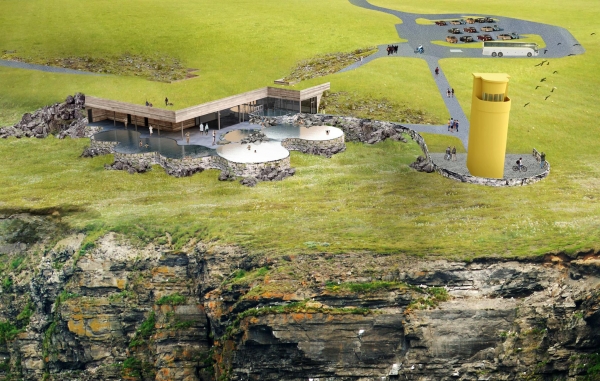Work on the Geothermal seawater-baths located just north of the town Húsavík which started last September is going well. The construction is planned to take roughly a year and a half, allowing the first guests to soak in geothermal seawater sometime early spring 2018. According to the engineering firm Verkís, which handles all engineering issues on the project, the baths will use geothermal water from three nearby boreholes, some of which produce geothermal seawater.
Read more: Plans to build geothermal baths north of Húsavík village, North Iceland, set into motion
In addition to the baths themselves, which will be composed of several pools, the facilities will include a service center and ultimately an adjacent hotel. The baths themselves will be open to the general public. The pool area will be 500 square meters (5,400 sq ft), and the service center 600 sq m (6,500 sq ft).
The baths will overlook the Skjálfandi fjord and the North Atlantic, and according to Basalt Architects, who designed the baths, the goal of the project is to underscore and strengthen local characteristics, thus the building´s form and materiality should reflect its surroundings. Emphasis will be placed on stunning views and maintaining the tranquility of the site through simple, respectful architecture.
Currently Húsavík is primarily known for its whale-watching opportunities. The North East of Iceland has seen growing numbers of visitors in recent years. The nearby Mývatn nature baths currently offer an experience similar to that offered by the Blue Lagoon.
Read more: Iceland's two blue water pools: The Blue Lagoon vs. Mývatn Nature Baths
The water in the baths will be 38-39°C (100-102°F). Rather than adding chlorine or purifying the water with other chemical or mechanical methods the designers plan to simply have the flow of water in the baths rapid enough to ensure the water is always clean, freshly extracted geothermal water. The flow will be 35 liters per second (9 gallons per second). As the new water is pumped into the pools, the excess water flows over their banks, and is collected into a stream which then runs down into the beach and the ocean.

Work on the Geothermal seawater-baths located just north of the town Húsavík which started last September is going well. The construction is planned to take roughly a year and a half, allowing the first guests to soak in geothermal seawater sometime early spring 2018. According to the engineering firm Verkís, which handles all engineering issues on the project, the baths will use geothermal water from three nearby boreholes, some of which produce geothermal seawater.
Read more: Plans to build geothermal baths north of Húsavík village, North Iceland, set into motion
In addition to the baths themselves, which will be composed of several pools, the facilities will include a service center and ultimately an adjacent hotel. The baths themselves will be open to the general public. The pool area will be 500 square meters (5,400 sq ft), and the service center 600 sq m (6,500 sq ft).
The baths will overlook the Skjálfandi fjord and the North Atlantic, and according to Basalt Architects, who designed the baths, the goal of the project is to underscore and strengthen local characteristics, thus the building´s form and materiality should reflect its surroundings. Emphasis will be placed on stunning views and maintaining the tranquility of the site through simple, respectful architecture.
Currently Húsavík is primarily known for its whale-watching opportunities. The North East of Iceland has seen growing numbers of visitors in recent years. The nearby Mývatn nature baths currently offer an experience similar to that offered by the Blue Lagoon.
Read more: Iceland's two blue water pools: The Blue Lagoon vs. Mývatn Nature Baths
The water in the baths will be 38-39°C (100-102°F). Rather than adding chlorine or purifying the water with other chemical or mechanical methods the designers plan to simply have the flow of water in the baths rapid enough to ensure the water is always clean, freshly extracted geothermal water. The flow will be 35 liters per second (9 gallons per second). As the new water is pumped into the pools, the excess water flows over their banks, and is collected into a stream which then runs down into the beach and the ocean.








